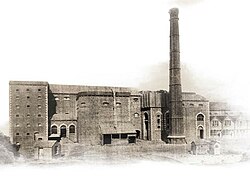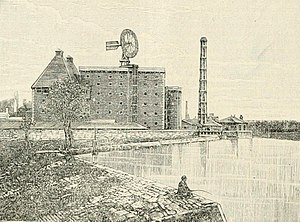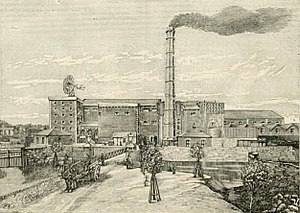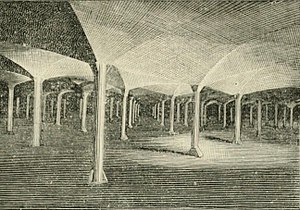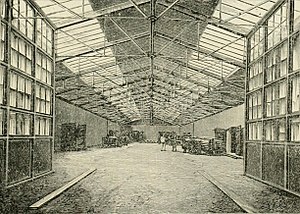
Irish whiskey is whiskey made on the island of Ireland. The word 'whiskey' comes from the Irish uisce beatha, meaning water of life. Irish whiskey was once the most popular spirit in the world, though a long period of decline from the late 19th century onwards greatly damaged the industry, so much so that although Ireland boasted at least 28 distilleries in the 1890s, by 1966 this number had fallen to just two, and by 1972 the remaining distilleries, Bushmills Distillery and Old Midleton Distillery, were owned by just one company, Irish Distillers.
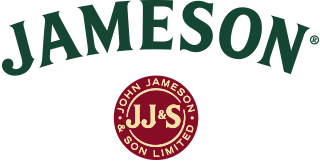
Jameson is a blended Irish whiskey produced by the Irish Distillers subsidiary of Pernod Ricard. Originally one of the six main Dublin whiskeys at the Jameson Distillery Bow St., Jameson is now distilled at the New Midleton Distillery in County Cork. It is by far the best-selling Irish whiskey in the world; in 2019, annual sales passed 8 million cases. It has been sold internationally since the early 19th century, and is available to buy in over 130 countries.
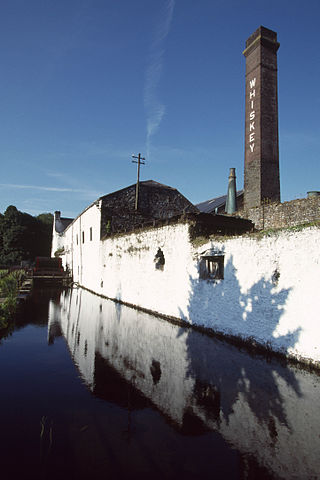
Kilbeggan Distillery is an Irish whiskey distillery situated on the River Brosna in Kilbeggan, County Westmeath, Ireland. Founded in 1757 the distillery is owned by Suntory Global Spirits, a subsidiary of Suntory Holdings of Osaka, Japan.

Powers is a brand of Irish whiskey produced by the Irish Distillers subsidiary of Pernod Ricard. Historically a single pot still whiskey, the flagship Powers Gold Label brand was the first Irish whiskey ever to be bottled. Powers Gold Label was the best-selling whiskey in Ireland.
Jameson Distillery Bow St. is an Irish whiskey tourist attraction located just off Smithfield Square in Dublin, Ireland. Jameson Distillery Bow St. is the original site where Jameson Irish Whiskey was distilled until 1971. It is now a visitors centre that provides guided tours, tutored whiskey tastings, JJs bar and a gift shop.

The Jameson Experience, Midleton, is an Irish whiskey museum and visitor centre located in the Old Midleton Distillery in Midleton, County Cork, Ireland. Set over 15 acres, since opening as a visitor's centre in 1992, the old distillery has received approximately 100,000 guests per year, receiving 125,000 in 2015.
Allman's Bandon Distillery was an Irish whiskey distillery which was established in 1826 in Bandon, County Cork, Ireland. The distillery closed in 1929 following financial difficulties. However, agents for the company trading under the name Allman, Dowden & Co., may have continued to sell off the existing stock which had built up in bonded warehouses, in both cask and bottled form, until 1939.
The Thomas Street Distillery was an Irish whiskey distillery located in Dublin, Ireland. At its peak, it was Dublin's largest and most productive distillery and with an output of over 2 million gallons per annum, twice that of John Jameson's acclaimed nearby Bow Street distillery. Alfred Barnard, a British author who visited most of the distilleries in the then United Kingdom of Great Britain and Ireland in the late 1880s, wrote that, at the time of his visit, the Thomas Street Distillery may have been the largest whiskey distillery in the world and probably had the highest output of any whiskey distillery in the British Isles. However, the distillery later entered into financial difficulties, and closed in 1926. Although most of the distillery buildings were demolished following its closure, a few were incorporated into the Guinness St. James's Gate Brewery and are still extant.

The Marrowbone Lane Distillery was an Irish whiskey distillery located on Marrowbone Lane, in Dublin, Ireland. One of the "big four" historical Dublin whiskey firms, it was run by William Jameson, a member of the Jameson whiskey dynasty. However, the whiskey now known as Jameson Irish Whiskey was not produced at this distillery, but at the separate enterprise run by John Jameson at the nearby Bow Street Distillery. The distillery closed in 1923 following financial difficulties.
The North Mall Distillery was an Irish whiskey distillery located in Cork City, Ireland. In its day one of the most famous distilleries in Ireland, the distillery was destroyed by a fire in 1920. Distilling operations never resumed at the North Mall after the fire, and it was later converted into a bottling and storage facility which was used by Irish Distillers until 2007, at which point operations were transferred to Irish Distillers' other bottling facilities in Dublin. In the mid-2000s, much of the site was jointly acquired by University College Cork and Mercy University Hospital, and has since been redeveloped.

Teeling Distillery is an Irish whiskey distillery established in Dublin in 2015 by the Teeling Whiskey Company and owned by Bacardi Limited.

The Dundalk Distillery was an Irish whiskey distillery that operated in Dundalk, County Louth, Ireland between 1708 and 1926. It is thought to have been one of the old registered distilleries in Ireland. Two of the distillery buildings, the grain store and maltings, still exist and now house the County Museum and Dundalk Library.

Daly's Distillery was an Irish whiskey distillery which operated in Cork City, Ireland from around 1820 to 1869. In 1867, the distillery was purchased by the Cork Distilleries Company (CDC), in an amalgamation of five cork distilleries. Two years later, in 1869, as the smallest CDC distillery, Daly's Distillery ceased operations. In the years that followed its closure, some of the buildings became part of Shaw's Flour Mill, and Murphy's Brewery, with others continuing to be used as warehouses by Cork Distilleries Company for several years.
The Green Distillery was an Irish whiskey distillery which was established in Cork City, Ireland in 1796. In 1867, the distillery was purchased by the Cork Distilleries Company (CDC), in an amalgamation of five Cork distilleries. Production of whiskey at the distillery likely ceased soon afters its acquisition by the CDC. However, the distillery is known to have remained in use a bonded store by the Cork Distilleries Company for several years thereafter. In the mid-twentieth century, the distillery resumed operations as a gin distillery for a period of time, however, it has since been almost completely demolished.
The Watercourse Distillery was an Irish whiskey distillery which was established in Cork City, Ireland in 1795. In 1867, the distillery was purchased by the Cork Distilleries Company (CDC), in an amalgamation of five Cork distilleries. Following the amalgamation, the distillery was mothballed for a period at the beginning of the 20th century. However, operations at the distillery were later resumed, with production of yeast, industrial alcohol and grain alcohol occurring at the distillery until the 1970s. Distillation ceased at the facility in 1975, when Irish Distillers, who at that stage owned the Watercourse along with several other distilleries in the Republic of Ireland consolidated its operations in a new, purpose-built distillery in Midleton.
The Old Tullamore Distillery was an Irish whiskey distillery which was established in Tullamore, County Offaly, Ireland, in 1829. The original home of Tullamore Dew Irish whiskey, the distillery closed in 1954, having endured financial difficulties for many years, like many Irish whiskey distilleries of the early 20th century.
John Brannick was an Irish whiskey maker, and founder and master distiller of the Dublin Whiskey Distillery Company.

Bishop's Water Distillery was an Irish whiskey distillery which operated in Wexford, Ireland between 1827 and 1914. The distillery was named for a stream which ran along the back of the distillery, the Bishop's Water, said to possess "various occult properties derived from the blessings of the sainted Bishop of Ferns".

Nun's Island Distillery was an Irish whiskey distillery which operated in Galway, Ireland, from at least 1815, and possibly as early as the late 1700s, until circa 1908.
Master distiller is a title often used for a distilling expert or a key leader or owner at modern distilleries. The title doesn't have a fixed definition and can mean different things at different companies. Although the craft of distilling has existed for centuries throughout history, the term "master distiller" only dates back as far as the 1800s when it was first used to acknowledge the distilling expertise and knowledge a person gained after practicing and perfecting the craft of distilling for many years. In more recent usage, the term can have a much broader meaning and is sometimes used for owners and company leaders who run their companies but do not actively create the distilling recipes and processes used at their distilleries.
